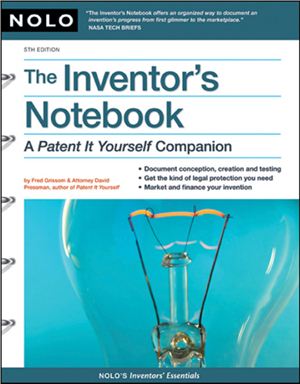Издательство Nolo, 2008, -260 pp.
5th edition
If you’re an inventor, you’re probably aware of the four main activities that all successful inventors must normally undertake:
conceiving, building, and testing the invention
legally protecting the invention
marketing the invention, and
financing the first three tasks.
The Inventor’s Notebook is designed to help you organize the records you need to successfully complete each of these activities. Specifically, The Inventor’s Notebook will show you how to document the details of your invention in order to:
Maintain good records of your inventing process. By doing this you will always know exactly where you are in the invention process and what remains to be done. This will help you avoid dead ends and the repetition of mistakes.
Create a legal record that you are the first and true inventor. If your invention is ever challenged, your completed notebook will be the foundation of the legal protection for your idea.
Convince others of the worth of your invention.
Proceed realistically in terms of your invention’s commercial potential.
Organize all the information pertaining to your invention in one location.
The Inventor’s Notebook is designed for a single invention. You should use a separate book for each invention. The purpose of The Inventor’s Notebook is to provide you with an organized means for documenting your inventive efforts. We do not explain here the details of patent law or the intricacies of how to create and run a business based on your invention. Before devoting your time, energy, and economic resources to an invention, it is appropriate to figure out the relationship between what you might put into the invention and what you expect to get out of it. In this sense, launching an invention is the same as starting a business—in both situations you should carefully calculate your profit potential before you get in too deeply. It is this activity that we refer to when we later speak of creating a business plan for your invention.
Nolo also publishes Patent It Yourself, an excellent source of detailed information on obtaining and using a patent. For a full understanding of the legal principles associated with the information you will be entering in The Inventor’s Notebook, we recommend that you obtain a copy of this comprehensive and clearly written resource. It is widely available in libraries and bookstores, and can also be obtained by ordering directly from Nolo. See the Nolo catalog and ordering information at the back of this book. In Patent It Yourself, author David Pressman has formulated numerous statements or instructions (termed Inventor’s Commandments) that focus the reader’s attention on the crucial steps necessary to the successful development of his or her invention. Throughout The Inventor’s Notebook we provide cross-references to the relevant portions of Patent It Yourself and feature some of its Inventor’s Commandments where appropriate.
Introduction
Using the Notebook
Legal Protection
Marketing
Financing
Help Beyond This Book
Appendixes
I Notebook
II Worksheets
III Glossary
IV Fee Schedule
V Tear-Out Forms
5th edition
If you’re an inventor, you’re probably aware of the four main activities that all successful inventors must normally undertake:
conceiving, building, and testing the invention
legally protecting the invention
marketing the invention, and
financing the first three tasks.
The Inventor’s Notebook is designed to help you organize the records you need to successfully complete each of these activities. Specifically, The Inventor’s Notebook will show you how to document the details of your invention in order to:
Maintain good records of your inventing process. By doing this you will always know exactly where you are in the invention process and what remains to be done. This will help you avoid dead ends and the repetition of mistakes.
Create a legal record that you are the first and true inventor. If your invention is ever challenged, your completed notebook will be the foundation of the legal protection for your idea.
Convince others of the worth of your invention.
Proceed realistically in terms of your invention’s commercial potential.
Organize all the information pertaining to your invention in one location.
The Inventor’s Notebook is designed for a single invention. You should use a separate book for each invention. The purpose of The Inventor’s Notebook is to provide you with an organized means for documenting your inventive efforts. We do not explain here the details of patent law or the intricacies of how to create and run a business based on your invention. Before devoting your time, energy, and economic resources to an invention, it is appropriate to figure out the relationship between what you might put into the invention and what you expect to get out of it. In this sense, launching an invention is the same as starting a business—in both situations you should carefully calculate your profit potential before you get in too deeply. It is this activity that we refer to when we later speak of creating a business plan for your invention.
Nolo also publishes Patent It Yourself, an excellent source of detailed information on obtaining and using a patent. For a full understanding of the legal principles associated with the information you will be entering in The Inventor’s Notebook, we recommend that you obtain a copy of this comprehensive and clearly written resource. It is widely available in libraries and bookstores, and can also be obtained by ordering directly from Nolo. See the Nolo catalog and ordering information at the back of this book. In Patent It Yourself, author David Pressman has formulated numerous statements or instructions (termed Inventor’s Commandments) that focus the reader’s attention on the crucial steps necessary to the successful development of his or her invention. Throughout The Inventor’s Notebook we provide cross-references to the relevant portions of Patent It Yourself and feature some of its Inventor’s Commandments where appropriate.
Introduction
Using the Notebook
Legal Protection
Marketing
Financing
Help Beyond This Book
Appendixes
I Notebook
II Worksheets
III Glossary
IV Fee Schedule
V Tear-Out Forms

